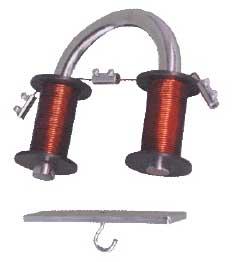

Eager to demonstrate electromagnetic phenomena to his students, Henry built upon the work of English scientist William Sturgeon, who in 1825 discovered that wrapping a wire around an iron core enhanced the magnetic effect. Danish scientist Hans Christian Oersted had discovered in 1820 that an electrical current in a wire from a battery caused a nearby compass needle to deflect. The field of electromagnetism was only six years old when Henry began teaching at the Albany Academy in New York. He also discovered important principles of electromagnetic induction, for which he was honored in 1893, when the International Congress of Electricians named the unit of induction the "henry." Henry's work in electromagnetism not only made important contributions to science, but helped lay the groundwork for modern industry and telecommunications. Although he did not further develop these devices, his work paved the way for the development of motors by others and for Samuel F. Using these electromagnets to demonstrate both dramatic and subtle effects to his students and to explore electromagnetism in the laboratory, he developed the first motor based on magnetic attraction and repulsion (a forerunner of a modern DC or direct current motor) and a primitive form of the electromagnetic telegraph. Henry was an innovative teacher whose interest in the relatively new field of electromagnetism, combined with his belief in the importance of demonstrating scientific phenomena to his students, led him to develop electromagnets that were far more powerful than any previously made. During these years, he became known among scientists throughout the United States and Europe for his groundbreaking research in electromagnetism. Henry was a physicist who had taught for some twenty years, first at a college preparatory school in New York and then at Princeton. As you will see in the next page, alternating current (AC), on the other hand, is constantly changing its direction of flow, so a reversing switch is not necessary.Joseph Henry, who became Secretary of the Smithsonian upon its establishment in 1846, was the first in a long line of scientists selected to lead the Institution. So, in order to change the direction of flow change, there needs to be a reversing switch. Direct current (DC) flows in only one direction through a wire. In fact, each time the current is reversed, the north and south poles will exchange places. When you reverse the current again, the north and south poles reverse again.

When you reverse the direction of the current flowing in the wire, the north and south poles are also reversed. One end of the magnet becomes a north pole and the other end becomes the south pole. In the experiment you just finished, when you turn the current on, the current flows through the wire and temporarily magnetizes the bar of iron material. In the experiment above and the experiment below, we see that magnetism can also let us do the opposite that is, we can convert electricity into mechanical energy. In the experiment above, you saw how magnetism makes it possible to convert mechanical energy into electrical energy, allowing electric generators to make electricity. So, let's see how electricity is able to make a magnet. When the electricity was turned off, the magnetizing cause was no longer present, so the object was not attracted to the iron crane. As long as the electric current was on, the iron crane was a magnet and could pick up ferromagnetic objects. In this experiment you used electricity to make a temporary magnet, called an electromagnet. How can electricity be used to make a magnet?


 0 kommentar(er)
0 kommentar(er)
